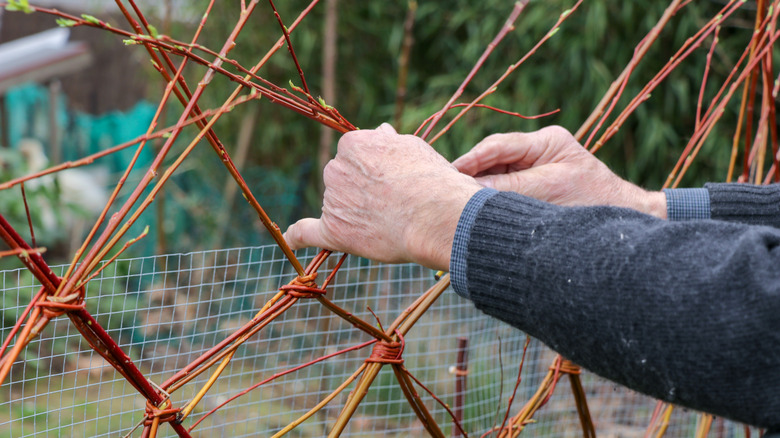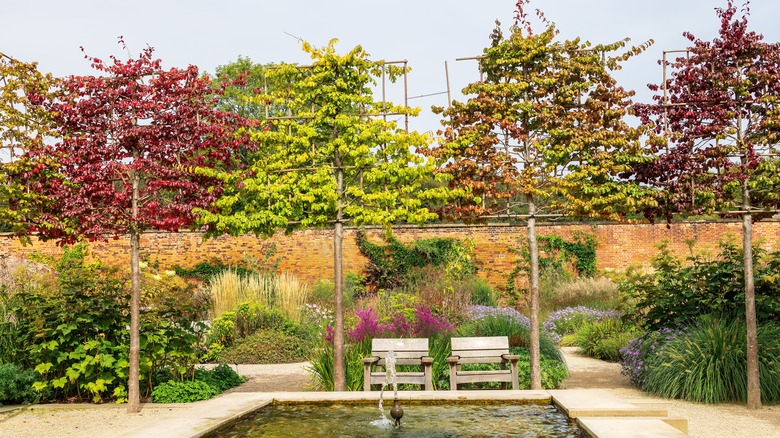This Tree-Growing Technique Is The Perfect Privacy Solution For Small Backyards
Having a garden, patio, or backyard means having a comfortable green space where you can relax, surrounded by family and friends, and most importantly, no one else. When it comes to enjoying our backyards, we simply crave privacy. Whether you're in the middle of a bustling city or a sprawling suburb, there are several ways to make your backyard feel more private, using a structure like a pergola or gazebo, planting tall trees, or installing a fence.
These days, however, a fence tall enough to block the view may be an issue, given zoning laws or HOA rules. Additionally, a tall fence can make a small yard look even smaller, especially if the fence is solid wood or metal with no gaps. Fortunately, there is a tree-growing technique called pleaching that is the perfect privacy solution for small backyards. Learning the best plants to use to create a private patio space is one possible answer, but this solution is all about a method to grow the plants you may already have rather than adding a particular type.
Using pleached trees in your yard
Think of pleaching as a hedge or canopy on stilts, with branches carefully woven through a lattice that disappears from sight as the branches grow. Pleaching is really just a method to train tree branches along a prescribed shape that you determine by tying growing branches to a frame 1.3 to 1.9 yards (120–180 cm) wide. The more mature the tree, the more support it needs. Frames can be handmade, but premade frames are stainless steel, wood, or bamboo. A quick search for something to support plants or trees might turn up a common trellis, and this can work as well — just horizontally, not vertically.
To wrap your backyard in a blanket of greenery using this technique, plant trees that have long, pliable branches along a fence line or a straight border. Trees should be planted 3 feet apart, with a clearly defined vertical stem and no growth until branches reach the desired height. Use support posts to secure the trees and their pleaching frames. In spring, when the trees sprout branches, weave them through the lattice of your choice to create a flat privacy screen, like a green fence, but several feet above ground level. No matter what frame or lattice you use, be sure to work with flexible rubber ties or bands to guide branches into the desired shape, so you don't cut into the growing branches.
Use these trees for pleaching
Trees that are recommended for pleaching include lime trees, hornbeam, crab apple, cherry, and photinia, a shrubby tree with glossy leaves that's related to roses and is originally from Southeast Asia. Pleached trees do require regular maintenance to keep them from becoming too bushy or too tall. This means pruning twice a year, on both sides of the lattice, to keep the tree's flat shape. Pruning should be done once in winter when the branches are dormant, and once in early summer after branches have been woven into the lattice. Like any tree, your privacy screen needs regular watering.
Pleaching works in backyards of many sizes, but especially smaller ones, since a solid wall of fencing towering over the yard is no one's idea of charming or welcoming. With pleaching, because it elevates the greenery to a precise height and width that you determine, your trade in the mass of a continuous blob with a blooming and light-filtering arrangement of trained branches that offers greenery but also privacy, giving your backyard definitive, architectural element. However, if you decide pleaching is not for you, we have over two dozen other landscaping ideas that will create privacy in your backyard.


